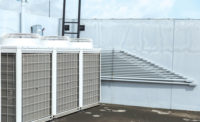Designing a hospital or outpatient medical facility can be challenging with the need to adhere to multiple codes and guidelines, equipment coordination, and the possibility of problems beyond occupant comfort. At the most basic level, HVAC engineers who design health care facilities are responsible not only for ventilation and occupant comfort but also for taking into account the chemical, physical, and biological contaminants that are present in a health care environment.
ASHRAE 170-2017 covers patient care areas of health care facilities in new buildings, additions to existing buildings, and alterations to existing buildings. It provides a guideline for health care facility safety and dictates the air changes per hour required in health care settings, pressure relationship requirements, exhaust requirements, filtration and air distribution requirements, humidity and temperature requirements, and much more.
ASHRAE 170, “Ventilation for Healthcare Facilities,” was first published in 2008 to address the specific ventilation needs in a health care environment. Prior to 2008, there was no specific standard available to address the minimum ventilation requirement for health care environments. Prior to 2010, ASHRAE standard 62.1, “Ventilation for Acceptable Air Quality,” contained Appendix E, which was specific to health care facilities. This part of the standard no longer exists and the requirements were completely transferred to ASHRAE 170 when it was issued in 2008. The standard has been incorporated in the Facility Guideline Institute’s “Guideline for Design and Construction of Healthcare Facilities” since 2010.
Planning
When designing a health care facility, the first and most important step is understanding the programming of the space and identifying specific user needs or requests. Section 5 of ASHRAE 170 outlines the requirements for the planning stages of health care design. The owner and architect should determine what activities and procedures will occur in each space and if they or their doctors have any special temperature or humidity requirements. This is the stage where it should be determined if there are additional requirements stipulated by the user beyond ASHRAE 170. This could include providing lower or higher temperatures than the prescribed 68º-75ºF air in operating rooms or pharmacies, or higher humidity in burn units. It should be noted that this ventilation standard only serves as a minimum requirement and does not prevent a more stringent approach by city, state, or federal government.

FIGURE 1. The emergency department trauma room at Virginia Commonwealth University’s Hospital System.
Medical equipment that will be located in each space should be determined during the planning stage as well. Air change, pressurization, and exhaust requirements of rooms and departments must be compared to actual heating and cooling loads within the room. This includes everything from typical loads, such as the envelope, lights, and people, and specialty equipment, like refrigerators, sterilizers, and major imaging equipment.
The equipment in rooms will produce heat and may require special ventilation. Imaging equipment may have chilled water supply needs, containment hoods may have duct connections to exhaust systems, and workstations may have specific compressed gas, vacuum, or filtered water requirements. Duct routing will need to be considered to avoid cable trays from specialty equipment rooms to the equipment or to avoid copper shielded rooms. Site-specific equipment cut sheets, provided by the selected medical equipment vendor, should provide any specialized requirements and will help fill in details not covered by the code. Determining equipment requirements and layouts will greatly simplify design in heavy equipment rooms, such as imaging rooms, lab spaces, sterile processing areas, and operating rooms.
A magnetic resonance imaging (MRI) room site-specific layout from a manufacturer will give far more information than the minimum air change requirements from ASHRAE 170 table 7.1. These documents should provide the heat load from the equipment, chilled water supply requirements, and humidity ranges. It should also detail important life safety information, like quench vent requirements, oxygen deprivation sensors, and emergency exhaust fan placement. Each imaging vendor has slightly different requirements and allowances. In theory, medical equipment should be selected before MEP design begins; however, most times the room types will help the engineer to make preliminary assumptions until the design is more advanced.

FIGURE 2. The University of Virginia’s Battle Building.
Equipment selection
When selecting HVAC systems and equipment, safety and continuous operation of the hospital or health care facility are the top priorities. Dependent of facility and space requirements, much of the HVAC equipment and controls will be on emergency power. This may include exhaust fans, heating equipment, and supply and return fans. Some facilities are requesting that additional systems, such as chilled water pumps and chillers, be placed on emergency power as well. Critical rooms, such as airborne infection isolation rooms, protective environment rooms, and operating rooms — including caesarean section rooms — must remain fully operational during a power outage. All space ventilation and pressurization requirements must be continuously met. This may be different for outpatient facilities where the emergency power requirements will depend on the accreditation agencies and the owner’s requirements.
Redundancy in heating equipment is aimed at eliminating downtime in the event of failure or maintenance but is function-based rather than capacity-based. ASHRAE 170, Section 6.1.2, dictates that heating must be available for sterilization, dietary function, operating, delivery, labor, recovery, emergency, ICU, nursery, and inpatient care. Redundancy must be provided for equipment serving all of these spaces. For cooling equipment, any systems greater than 400 tons must have a redundant system in case of breakdown or maintenance, and redundancy may be treated more as purely n+1 rather than as a means of keeping certain operations functioning.

TABLE 1. ASHRAE 170, 2017 Table 6.4.
Air filtration is a primary means of reducing the concentrations of airborne bacteria that causes hospital acquired infections (HAI). Filtration in ASHRAE 170 and filter placement for patient care spaces is detailed in Section 6 and Table 6.4. In spaces requiring two filter banks, the first filter must be placed upstream of the heating and cooling coils to protect the coils from buildup. The second filter is placed downstream of all other sections in the unit, including the humidifier and supply fans, and is meant to provide clean air to the space. Generally, a hospital will have units with pre and final filtration, often with additional HEPA filtration in the ceilings of critical spaces, such as operating rooms, pharmacies, and protective environment rooms. When placing HEPA filters, it’s important to take into account the static pressure drop of the dirty filter, and a differential pressure sensor should be placed across at least one filter in each room. Filters should be replaced based on pressure drop. All final filters shall have sealing interface surfaces, and room-side HEPA filters should be provided with a knife-edge gel seal to prevent any unfiltered air from leaking into the space. Aerosol test ports should be provided upstream of any HEPA filter to verify the integrity of the gel seal.
Section 7
Section 7 provides the most commonly referenced and recognizable table of the code, Table 7.1. This table provides the minimum requirements for various patient care and patient support areas commonly encountered in health care environments. It outlines the pressure requirements, outdoor and total air change requirements, exhaust requirements, recirculation allowances, and acceptable humidity and temperature ranges. Ventilation rates for areas not specified in this table should be met with standards from ASHRAE 62.1. Those areas that are defined by both codes will provide the higher of the two air change rates.
Pressure relationships
The first column of Table 7.1 outlines the pressure relationship between the room detailed and adjacent areas. Air should always flow from clean areas to dirty areas of the health care facility, and any areas with an outlined pressure requirement must maintain a minimum pressure differential of 0.01-inch WG. Pressure-monitoring devices should be installed in operating rooms, delivery rooms, airborne infection isolation rooms, protective environment rooms, and central sterile departments. Pressure-monitoring devices with a visual alarm are only required in combination airborne infection isolation rooms and protective environment rooms, but both airborne infection isolation rooms and protective environment rooms require daily pressure testing when occupied by an affected patient, and a pressure-monitoring device should be installed. These monitors should also be installed in operating rooms, compounding pharmacies, and central sterile department suites.

TABLE 2. ASHRAE 170, 2017 Table 7.1 (partial).
Under no circumstances may the pressurization of a room be switched except with a combination airborne infection isolation room and protective environment room (AII/PE). In this case, an anteroom is required to serve as an additional barrier. This means a procedure room (a positively pressurized room) may not serve as a bronchoscopy room (a negatively pressurized room) one day and have its pressure switched the next. The combination AII/PE room must have two permanent devices or mechanisms to monitor the differential pressure — one that is installed between the room and the ante room and the other between the ante room and the corridor. Both are required to have a local or visual means to indicate whether the rooms are complying with the pressure relationship.
Pressurized rooms may be turned down for energy recovery purposes but must always maintain their pressure differential. This is particularly advantageous in high air change rooms, such as operating rooms. These rooms are generally not used at night and require high air changes. They may be turned down, though it’s not recommended that they be turned down below six air changes. In order to ensure that pressure is maintained, supply and return air tracking valves should be used. These fast-response boxes track a predetermined offset to maintain room pressurization. This can offer a significant energy savings to the facility by allowing fan systems to slow down and cooling and heating systems to condition less air. The energy savings that can be recognized are dependent upon how often these rooms can be set back.
In any area that has a pressure requirement, all systems must be fully ducted. All patient care areas in inpatient care facilities, recovery, critical, and intermediate care areas and burn units must also be fully ducted. This often means that HVAC engineers will require additional ceiling plenums or interstitial space in order to fit all the required ductwork. While this means there are some areas of a hospital that would not have this requirement, best practice dictates a fully ducted building for inpatient care.
Humidity
Relative humidity ranges for patient care spaces are found in the second to last column of Table 7.1. ASHRAE 170 allows a wide range for acceptable humidity. Often, there is no minimum humidity requirement; however, humidity that is either too high or low can encourage bacteria and virus growth. Low humidity levels can also cause premature coagulation during surgery or cause increased static on imaging machines, affecting their image clarity and even damaging equipment.
Generally, winter humidity levels are set at 30% rh and summer maximum humidity is set at 60%. Room-specific requirements determined during the planning stage and specific equipment requirements should also be taken into consideration here. Burn units may be provided with higher humidity than outlined by ASHRAE 170, as this creates a more comfortable environment for burn victims, aids in healing, and prevents excessive scarring. Burn unit patient rooms require individual humidity control. The requirements for hospital accreditation often require relative humidity, temperature, and pressures be documented and recorded. New technologies can be implemented by trending this data on the building automation system and sending reports of the system performance to the appropriate individuals responsible for keeping those records.

TABLE 3. ASHRAE 170, 2017, Table 6.7.2.
Humidification is generally provided at the unit level though it may be provided in ductwork for spaces with special humidification requirements. Humidification in the ductwork may not exceed 90% rh, and a duct sensor is required downstream of the injection source. Reservoir-type or evaporative pan humidifiers are prohibited, but ASHRAE 170 Section 6.6 now allows adiabatic, high-pressure water-atomizing humidifiers so long as reverse osmosis water is used in conjunction with ultraviolet sterilization and a submicron filter. This leads to steam still being the most popular method of humidification in health care facilities in temperate climates, especially as steam is often used for sterilization, and it’s typically available.
Exhaust requirements
Many rooms require air to be exhausted directly to the outdoors, and specialized exhaust is required in many areas of a health care facility. Many types of exhaust produced are classified as hazardous, and discharge should be handled as such. Exhaust generated from airborne infection isolation rooms, bronchoscopy and sputum collection and pentamidine administration rooms, emergency department public waiting areas, nuclear medicine hot labs, radiology waiting rooms programmed to hold patients who are waiting for chest x-rays for diagnosis of respiratory disease, pharmacy hazardous-drug exhausted enclosures, and laboratory work area chemical fume hoods is deemed as hazardous and must be discharged 10 feet above the roof level.
Lab work area chemical fume hoods must also discharge at a minimum velocity of 2,500 feet per minute. Exhaust from airborne isolation infection rooms, bronchoscopy and sputum collection exhaust, and laboratory work area chemical fume hoods must be located at least 25 feet from any outdoor air intakes and should be positioned to minimize entrainment to open windows and any intakes as well as any contact with the public. Exhaust from many areas in a health care facility, detailed in Section 6.8.3, may not be used in an energy recovery system with any leakage potential. Waste heat may only be recovered in a way that there is no risk of leakage such as with a pumped runaround coil or fixed-plate heat exchanger.
In areas with strict pressure requirements, exhaust air tracking valves should be used to maintain room pressure differentials and proper exhaust levels. Airborne infection isolation rooms require a dedicated exhaust system; however, multiple airborne isolation rooms may be placed on the same fan. These rooms, protective environment rooms, and most lab spaces, especially those with ducted exhaust connections to fume hoods, would benefit from the use of return or exhaust tracking. Air flows could be reduced when not serving an affected patient to six ACH from 12 ACH. Fume hood tracking boxes could lower airflow when sash positions are lowered. This would save energy and eliminate turbulence concerns at the hoods created by high hood face velocities.
Air distribution
Correct air distribution devices must be used in spaces outlined in Table 6.7.2. This is most critical in areas where laminar airflow is required — those areas that require Group E (vertical throw) non-aspirating diffusers. ASHRAE 170 dictates placement of the diffusers in relation to patients in sections 6.7 and 7.2. The most stringent diffuser placement requirements are for operating rooms. In an effort to create a sterile field during operations, 70% of the area directly over the surgical table and 1 foot out from the table must be covered with nonaspirating Group E diffusers. The airflow from the laminar diffusers must be unidirectional and downwards, and the average velocity of the diffusers shall be 25-35 cfm/ft2. Two low-wall returns must be provided in opposite corners of the operating room. This attempts to create an even flow of air over the patients and doctors and minimize entrainment of room air into the sterile field.
The low-wall returns in the operating room also serve to pull anesthetic gases out of the operating room. Any rooms using anesthetic gas hard-piped into the room must also have low-wall returns mounted approximately 6 inches above finished floor. FGI 2018 dictates that any imaging procedure rooms with these gases, such as cardiac catherization labs or electrophysiology labs, should be designed to the same standards as an operating room. This includes air change and diffuser array requirements, which had formerly been designated as procedure rooms.
Placement of equipment for surgical areas and inpatient care areas should aim to minimize maintenance staff entrances into these areas. All terminal boxes and humidifiers should be placed in corridors whenever possible. Piping should not be run over imaging rooms or operating rooms and must be panned with drainage to an obvious location if this is not possible.
Conclusion
Every effort must be made to ensure the continuous operation of all areas in a health care facility. ASHRAE 170 attempts to outline how design engineers may design a building capable of providing continuous care in the safest way possible for both patients and staff. The guideline is constantly evolving in light of new studies and products to accomplish this. Design engineers should use these codes as a guideline but be prepared to go above and beyond the code when necessary to provide the highest quality, most comfortable, and controlled spaces to the most vulnerable populations.





